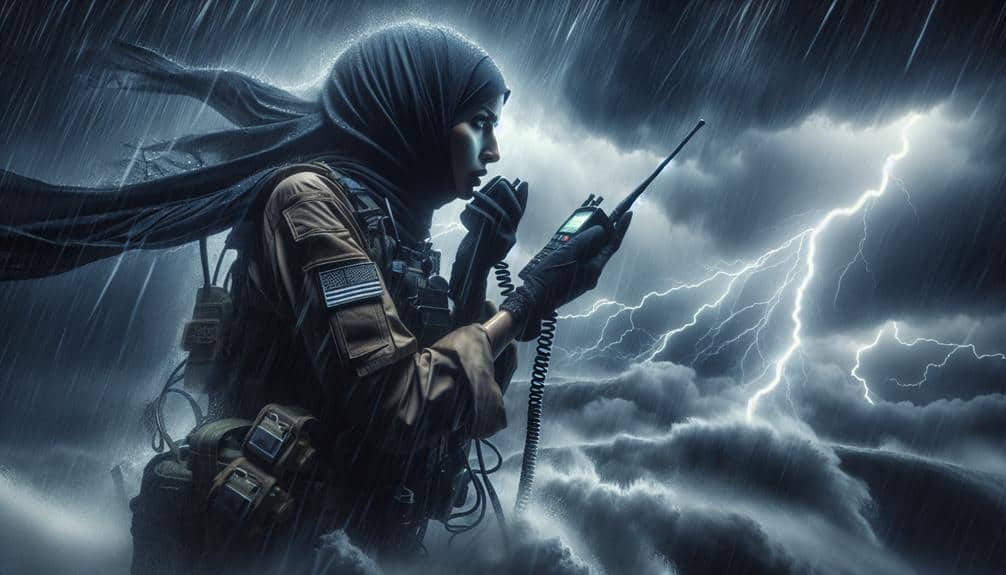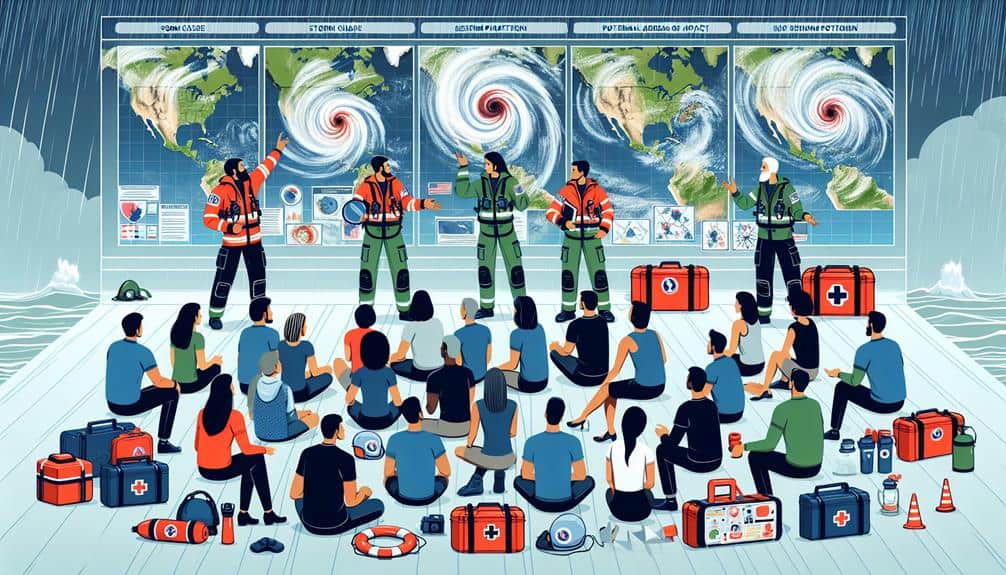We must adhere to best practices for hurricane chasing to safeguard public welfare and safety. We prioritize risk assessments, maintain well-equipped emergency kits, and use advanced meteorological tools. By collaborating with local authorities and maintaining robust communication via satellite phones and radios, we enhance response efficiency. We meticulously share real-time data while safeguarding its integrity. Respecting evacuation orders and tailoring strategies for vulnerable populations are critical. Ethical practices include minimizing interference, promoting public education, and protecting privacy. Adhering to these protocols equips us to manage risks effectively and support community resilience, considering further important details could be beneficial.
Key Points
- Conduct thorough risk assessments and adhere to safety protocols to ensure personal and public safety.
- Maintain reliable communication with local and federal agencies to share real-time data and coordinate emergency responses.
- Equip and train volunteers to support vulnerable populations during evacuations and disaster readiness.
- Use advanced meteorological tools for accurate weather updates and informed decision-making.
Prioritize Safety First
Before starting on any hurricane chasing mission, we must prioritize safety above all else by rigorously adhering to established protocols and continuously monitoring real-time weather updates. Our commitment to safety protocols and emergency preparedness guarantees that we can navigate the unpredictable nature of hurricanes while minimizing risk.
It’s essential to conduct thorough risk assessments before deployment. We analyze data from meteorological instruments and historical storm patterns to predict potential hazards and identify safe zones.
Effective communication strategies are crucial. We use encrypted radio systems and GPS-enabled devices to maintain constant contact with our team members. This allows us to quickly relay updates and adapt our plans based on evolving conditions. We also establish predefined check-in times to confirm everyone’s safety and location.
Emergency preparedness involves having a well-stocked kit, including first-aid supplies, water, non-perishable food, and sturdy protective gear. We don’t just rely on technology; we practice evacuation drills and emergency response scenarios regularly. This preparation empowers us to act swiftly and decisively when faced with unexpected challenges.
Use Reliable Equipment
Guaranteeing we use dependable equipment is vital to effectively and safely conducting hurricane chasing missions. Proper equipment maintenance is necessary to secure functionality during crucial moments. We must source our gear from trustworthy suppliers who provide high-quality, durable tools designed to withstand extreme conditions.
Regular inspections and timely repairs play an essential role in maintaining the integrity of our equipment, minimizing the risk of failure when we need it most.
Technology upgrades are another vital component. The rapid pace of technological advancement means that yesterday’s cutting-edge tools can quickly become outdated. Investing in state-of-the-art instruments, such as high-resolution Doppler radar and sturdy anemometers, enhances our ability to track and analyze storm patterns with greater accuracy. This, in turn, allows us to make more informed decisions and improve our safety margins.
Proper training is fundamental to maximizing the effectiveness of our equipment. It’s not enough to just have the latest technology; we need to ensure every team member is proficient in its use. In-depth training programs that cover both routine operations and emergency procedures will optimize our response capabilities.
Stay Informed on Weather Updates
Having reliable equipment is just one aspect of our mission; staying informed on real-time weather updates is equally imperative. In the domain of hurricane chasing, precise weather tracking is our lifeline. We rely on advanced meteorological tools, including Doppler radar, satellite imagery, and real-time data feeds from the National Hurricane Center. These resources enable us to monitor storm developments accurately, guaranteeing our safety and effectiveness in the field.
Our commitment to weather tracking isn’t just about our safety; it’s also about emergency preparedness. By staying updated with the latest forecasts and warnings, we can make informed decisions that not only protect us but also aid in relaying critical information to the public. Leveraging mobile apps, NOAA alerts, and specialized weather tracking software ensures we remain ahead of sudden changes in storm intensity or trajectory.
We must also integrate data from various sources to form a thorough picture of the hurricane’s behavior. This approach allows us to anticipate potential hazards and coordinate our actions accordingly. Staying informed isn’t just a best practice; it’s a necessity that empowers us to operate with freedom and confidence in the unpredictable environment of hurricane chasing.
Collaborate With Local Authorities
Partnering with local authorities is crucial for synchronizing our efforts and boosting the efficiency of our hurricane tracking and public safety initiatives. By forming community partnerships, we enhance disaster response capabilities and align our actions with local emergency preparedness protocols. This collaboration allows for a seamless exchange of real-time data, optimizing our tracking accuracy and enabling authorities to make informed decisions swiftly.
We must actively engage with local emergency management agencies, law enforcement, and public health departments. These entities possess invaluable localized knowledge and resources, which can greatly enhance our operational effectiveness. Community engagement initiatives, such as joint training exercises and public information sessions, foster trust and cooperation, ensuring all stakeholders are prepared for hurricane events.
Moreover, integrating our data collection and analysis tools with local authority systems can streamline communications and facilitate rapid, coordinated responses. For instance, sharing meteorological data and predictive models with emergency services allows for precise resource allocation and timely evacuation planning. This synergy not only expands our operational scope but also empowers communities to exercise their freedom responsibly and safely during hurricane threats.
Respect Evacuation Orders

When evacuation orders are issued, we must prioritize safety first, adhering to official directives to mitigate risk.
Promptly informing authorities about our plans and movements guarantees coordination and resource allocation.
Additionally, assisting vulnerable populations during evacuation can greatly reduce casualties and enhance community resilience.
Prioritize Safety First
Respecting evacuation orders is critical to guaranteeing both personal safety and public welfare during hurricane events. When meteorologists and emergency management teams issue evacuation directives, they’re based on rigorous emergency protocols and detailed risk assessment models. These orders aren’t merely suggestions; they’re essential measures grounded in data and expert analysis.
We must prioritize safety protocols above all else. Adhering to evacuation orders minimizes the risk of injury or death and guarantees that emergency resources are allocated effectively.
Communication strategies play a pivotal role in this process. By staying informed through reliable channels such as the National Weather Service and local emergency broadcasts, we can make informed decisions and act promptly.
As hurricane chasers, we value the freedom to explore and document extreme weather phenomena. However, we must balance this freedom with our responsibility to prioritize safety. Ignoring evacuation orders not only endangers our lives but also complicates rescue efforts and burdens emergency services. By respecting these directives, we contribute to a safer environment for everyone involved.
Inform Authorities Promptly
To guarantee effective disaster response, we must promptly inform authorities about our location and any relevant observations while respecting evacuation orders. Swift communication enhances public awareness and ensures that emergency response teams can allocate resources efficiently. By relaying real-time data, such as wind speeds, rainfall intensity, and damage assessments, we contribute to more accurate situational analyses.
Our adherence to evacuation orders isn’t just a legal obligation; it’s a crucial safety measure. By following directives, we reduce the risk of becoming casualties ourselves and avoid hampering rescue operations. Authorities rely on precise information to make informed decisions, and our cooperation enhances their ability to protect communities effectively.
In addition, we should utilize reliable communication channels, such as satellite phones and emergency radios, to maintain constant contact with local and federal agencies. Sharing our GPS coordinates and detailed weather reports can greatly improve the accuracy of emergency response efforts. It’s essential that we balance our pursuit of freedom and adventure with a commitment to public welfare and safety.
Ultimately, our role isn’t only to document these powerful storms but also to support the broader emergency response framework, ensuring that our actions contribute positively to community resilience.
Assist Vulnerable Populations
Assisting vulnerable populations during hurricanes requires us to adhere strictly to evacuation directives and provide targeted support based on real-time assessments. By focusing on individuals with limited mobility, the elderly, and low-income families, we can tailor our disaster readiness strategies to meet their specific needs. Outreach programs should be established to disseminate information quickly and efficiently, guaranteeing that everyone is aware of evacuation protocols and available resources.
We must prioritize community engagement, fostering a network of local volunteers and agencies that can assist in real-time. This network should be trained to execute evacuation directives seamlessly, minimizing confusion and enhancing the safety of vulnerable populations. Additionally, leveraging technology for real-time data collection and dissemination allows us to adjust our strategies dynamically, responding to changing conditions on the ground.
Effective disaster preparedness involves not only planning but also the active involvement of the community. It’s essential that we respect evacuation directives to prevent unnecessary risks and guarantee that our efforts are concentrated where they’re most needed.
Avoid Residential Areas
When we avoid residential areas, we minimize public disruption and respect private property.
This practice also guarantees public safety by reducing the risk of our activities interfering with evacuation or emergency response efforts.
Let’s prioritize these principles to maintain a responsible and ethical approach.
Minimize Public Disruption
Hurricane chasers should prioritize minimizing public disruption by steering clear of residential areas to reduce the risk of accidents and interference with emergency services. Our approach should emphasize public awareness and community outreach, ensuring that our presence doesn’t exacerbate the situation for local residents. By carefully planning our routes and choosing observation points outside populated zones, we can effectively gather data without becoming an impediment.
In addition, we must manage media relations carefully to maintain a positive public perception. It’s pivotal that we communicate our methods and objectives transparently to reassure communities that we’re acting responsibly. Clear and factual information dissemination can mitigate misunderstandings and foster trust. When we coordinate with local authorities and emergency services, we enhance our capability to chase safely and reduce our impact on those affected by the hurricane.
Data-driven strategies, such as using real-time GPS tracking and predictive modeling, enable us to avoid congested areas while still capturing valuable meteorological data. By prioritizing these methods, we not only protect public welfare but also uphold the integrity of our scientific endeavors.
Let’s remember, our mission is to study hurricanes, not to disrupt lives.
Respect Private Property
We must also respect private property by strictly avoiding residential areas, safeguarding our presence doesn’t infringe on individuals’ spaces or privacy. This adherence to private property rights is essential for maintaining ethical boundaries and fostering trust with the public.
When planning our routes and setting up equipment, we should always prioritize areas designated for public use or open fields, steering clear of homes and personal properties.
To effectively respect private property rights, we can follow these guidelines:
- Map Analysis: Use detailed maps to identify and avoid residential zones. This step safeguards we don’t inadvertently set up in someone’s backyard.
- Permits and Permissions: Secure necessary permits and permissions from local authorities, safeguarding our activities are legally sanctioned and ethically sound.
- Clear Boundaries: Establish clear boundaries for our operations, marked visibly to avoid accidental encroachment on private property.
- Public Areas: Focus our activities in public areas such as parks or open spaces where our presence is less likely to disrupt daily life.
Ensure Public Safety
To guarantee public safety, let’s prioritize avoiding residential areas during our hurricane chasing activities. By steering clear of these zones, we minimize the risk of causing additional distress or interference with local emergency response teams. Our presence can inadvertently escalate panic levels among residents and obstruct critical evacuation routes.
Data indicates that public awareness is vital during hurricanes. When we avoid populated areas, we encourage local authorities to focus on disseminating accurate information and coordinating emergency response efforts. This approach ensures that residents can make informed decisions based on reliable updates, without the added concern of maneuvering around unnecessary obstacles.
Moreover, our technical equipment, such as drones and weather instruments, can sometimes malfunction or cause unintentional damage. By operating in less populated areas, we reduce the likelihood of these incidents affecting homes and essential infrastructure. This practice not only preserves public safety but also upholds our responsibility as professional hurricane chasers.
Maintain Communication Lines

Effective communication channels are essential for maintaining timely updates and coordination among hurricane chasers, emergency responders, and the public. We must establish boundaries and maintain professionalism to guarantee that the information we share is accurate, timely, and useful. Our ability to keep the lines of communication open during these critical times can make a significant difference in public safety and operational efficiency.
To achieve this, we recommend the following:
- Utilize Reliable Communication Platforms: Make sure that we use platforms known for their stability and reliability, such as satellite phones or dedicated radio frequencies, which remain operational even when traditional networks fail.
- Establish Clear Protocols: Develop and adhere to standardized communication protocols that outline when and how to report data, ensuring that information is consistent and actionable.
- Coordinate with Local Authorities: Maintain a direct line of communication with local emergency management agencies to align our efforts and avoid misinformation.
- Implement Redundancy Systems: Set up backup communication systems to secure continuous information flow even if primary systems are compromised.
When we share data, we must guarantee its accuracy to maintain credibility and reliability.
Prioritizing public safety involves timely dissemination of information while adhering to privacy protocols to protect sensitive data.
Let’s commit to these principles to enhance the effectiveness of our hurricane response efforts.
Ensure Data Accuracy
Accurate data collection and responsible sharing are crucial for hurricane chasers to safeguard public safety and informed decision-making. We must focus on data validation and information integrity to guarantee that the data we gather and disseminate are both reliable and actionable.
Our data collection process should be meticulous and systematic, as inaccuracies can lead to compromised safety and misinformed choices.
To paint a clear picture, we should adhere to the following practices:
- Data Validation: Regularly cross-check collected data against multiple sources to verify precision.
- Information Integrity: Store and transmit data using secure channels to prevent tampering or corruption.
- Standardized Protocols: Implement and follow standardized data collection methods to ensure consistency and reproducibility.
- Real-time Updates: Provide timely updates to relevant authorities and the public to reflect the most up-to-date information.
Prioritize Public Safety
Our highest priority is to responsibly share real-time information with emergency services and the public to guarantee well-informed decision-making and improve safety measures.
We recognize the crucial role precise and timely information plays in risk assessment and emergency planning. By distributing accurate data, we empower communities to make decisions that protect lives and property.
We utilize cutting-edge technology to collect meteorological information, such as wind speeds, pressure readings, and trajectory forecasts. This data is shared with local authorities, allowing them to update evacuation routes, efficiently deploy resources, and issue timely alerts. Our dedication to data accuracy ensures that the public receives practical insights rather than false information.
Furthermore, we work closely with emergency management agencies to enhance risk assessment models. This partnership aids in pinpointing vulnerable areas and optimizing emergency plans tailored to specific community requirements.
When we share information, our aim is to strengthen community resilience and boost public confidence in emergency responses.
Respect Privacy Protocols
As we share critical meteorological data, we must also make certain that privacy protocols are meticulously followed to protect individual and community information. Respecting privacy boundaries while disseminating data reflects our dedication to ethical conduct and public trust. By adhering to these standards, we guarantee that our actions don’t infringe on personal freedoms or expose sensitive information.
To achieve this, we must implement the following steps:
- Data Anonymization: Before sharing data, verify that all personally identifiable information (PII) is removed. This includes names, addresses, and any other details that could trace back to individuals.
- Secure Data Transmission: Use encrypted channels for data transfer to prevent unauthorized access. This ensures that sensitive information remains confidential during transmission.
- Consent and Transparency: Always obtain explicit consent from data subjects before collecting their information. Clearly communicate how the data will be used and who’ll have access to it.
- Regular Audits: Conduct periodic audits to confirm compliance with privacy protocols. This helps identify potential vulnerabilities and reinforces our dedication to ethical conduct.
Educate the Public

How can we guarantee the public understands the complexities and risks associated with hurricanes? We need to focus on community education and disaster readiness. By leveraging data-driven insights, we can create targeted educational campaigns that address specific risks and mitigation strategies. Our goal is to empower individuals with the knowledge to make informed decisions, ultimately enhancing public awareness and emergency response.
We should utilize various platforms, including social media, community workshops, and local news outlets, to disseminate accurate and timely information. This approach ensures that our message reaches a broad audience, catering to different learning preferences. Integrating real-time data and predictive analytics can help us illustrate the potential impact of hurricanes, making the information more relatable and actionable.
Furthermore, collaborating with local authorities and emergency services can bolster our efforts. Joint training programs can simulate hurricane scenarios, providing hands-on experience in emergency response protocols. By involving the community in these drills, we foster a culture of readiness and resilience.
Ultimately, our mission is to guarantee that everyone has the freedom to protect themselves and their loved ones effectively. Through thorough community education and robust disaster readiness initiatives, we can achieve a safer, more informed society.
Promote Ethical Practices
To protect the integrity of our efforts, we must establish and adhere to ethical guidelines that prioritize both public safety and scientific rigor. Ethical conduct is our cornerstone, guaranteeing that our activities don’t compromise the well-being of the communities we study.
Our commitment to ethical practices involves the following key principles:
- Informed Consent: We must always communicate our intentions clearly to the local community. This transparency assures that they understand our presence and the potential risks and benefits of our research.
- Minimize Disruption: While gathering data, we should aim to minimize any interference with the community’s daily life. Our work shouldn’t worsen the challenges they face during a hurricane event.
- Data Integrity: Collecting accurate and reliable data is vital. We must use standardized methods and verify that our findings are reproducible and verifiable, thereby contributing meaningful insights to the scientific community.
- Community Engagement: Engaging with the community before, during, and after our research fosters trust and collaboration. By involving local stakeholders, we can better understand their needs and concerns, which ultimately enhances the relevance and impact of our work.
Frequently Asked Questions
What Qualifications Do You Need to Become a Hurricane Chaser?
To become hurricane chasers, we need specific training requirements and experience. We must understand meteorology, possess advanced equipment, and follow strict safety precautions. Proper gear, including communication tools and protective clothing, is essential for our safety.
How Can I Volunteer in Hurricane Relief Efforts?
Isn’t it a coincidence that we’re discussing volunteering just as hurricane season peaks? To volunteer in hurricane relief efforts, complete volunteer training. Then, assist in relief distribution to provide essential supplies and support to affected communities.
What Are the Psychological Impacts of Hurricane Chasing?
The psychological impacts of hurricane chasing include stress and mental health challenges. We must develop coping strategies and emotional resilience, utilizing effective stress management techniques to maintain our well-being while pursuing our passion for freedom and adventure.
How Are Hurricane Chasers Funded?
We rely on diverse funding sources, facing challenges like limited grants and budget constraints. Sponsorship opportunities from media and research institutions provide significant benefits, enabling us to continue essential data collection and improve forecasting models.
What Should You Pack for a Hurricane Chasing Expedition?
For a hurricane chasing expedition, we should pack emergency supplies like first-aid kits, non-perishable food, and water. Essential gear includes GPS devices, weather instruments, protective clothing, and communication tools to guarantee safety and accurate data collection.

